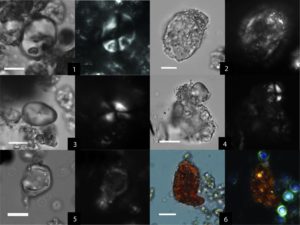HAIFA, Israel (Press Release) — Israeli, American, and German researchers have found the first evidence of the consumption of beer within a residential community, at the Chalcolithic settlement of Tel Tsaf, which dates back some 7,200 years.
 “We have already uncovered evidence highlighting the relative wealth of the residents of Tel Tsaf, including the storage of agricultural produce, and particularly grain, on a large scale. Now we have found evidence of the production and consumption of alcohol, in the form of a beer made from grain. We can imagine that the emerging society in Tsaf about 7200 years ago, held grand events at which large quantities of food was consumed and beer was drunk in a social setting, and not only for ceremonial purposes,” explains Prof. Danny Rosenberg the head of the Laboratory for Ground Stone Tools Research and Ancient Food Related Technologies, at the Zinman Institute of Archaeology, University of Haifa, who led the study alongside researchers from Stanford University and the German Institute in Berlin.
“We have already uncovered evidence highlighting the relative wealth of the residents of Tel Tsaf, including the storage of agricultural produce, and particularly grain, on a large scale. Now we have found evidence of the production and consumption of alcohol, in the form of a beer made from grain. We can imagine that the emerging society in Tsaf about 7200 years ago, held grand events at which large quantities of food was consumed and beer was drunk in a social setting, and not only for ceremonial purposes,” explains Prof. Danny Rosenberg the head of the Laboratory for Ground Stone Tools Research and Ancient Food Related Technologies, at the Zinman Institute of Archaeology, University of Haifa, who led the study alongside researchers from Stanford University and the German Institute in Berlin.
The oldest evidence of the consumption of beer was found at the Natufian burial site of Rakefet Cave on Mt. Carmel, dating back around 14,000 years. In a study published in 2014, the researchers from the University of Haifa and Stanford University found evidence of beer consumption – alcohol fermented from grain – associated with the Natufian burial ceremonies. According to Prof. Rosenberg, who also participated in the 2014 study, evidence of the consumption of beer in the Levant after the Natufian period has been fragmentary at best.
The settlement at Tel Tsaf in the Jordan Valley, which flourished during the Middle Chalcolithic period around 7200 years ago, was very large and inhabited by hundreds of people. Tel Tsaf is unique since it is one of the few sites in our region dating back to this transitional period. Researchers have already found evidence that the settlement was particularly prosperous over a period of several centuries, during which time its inhabitants accumulated agricultural produce on a very large scale and even developed extensive trade ties with areas hundreds of kilometers away, in Egypt, Jordan, Syria, and Iraq, and even in Anatolia.
In the new study, the researchers undertook microscopic examinations of starch grains from wheat and barley found in various clay vessels at Tel Tsaf, including sieves. They found that the grains had undergone internal morphological changes during the fermentation process showing that they were used in the production of alcohol. “The existence of this kind of system often required ‘ongoing maintenance,’ including the elevated consumption of alcohol,” the researchers noted.
According to the researchers, the production and consumption of beer did not end after the Natufian, as societies of hunter-gatherers began to settle permanently and engage in primary agriculture. Beer production certainly did not emerge spontaneously in the Bronze Age in the kingdoms of the ancient Middle East. They explain that their new discovery in Tel Tsaf was possible thanks to the excellent preservation conditions at the site, which enabled various organic materials to be preserved in an exceptional manner. In addition, this is precisely the kind of evidence they were looking for: signs of culinary practices at the site as part of their project examining the emergence of the Mediterranean diet in the region 7,000-8,000 years ago.
“For now, it is not easy for us to tell whether the beer produced by the process we are identifying in the remnants at Tel Tsaf was consumed daily or only at large social events attended by all or most of the community members. However, the accumulated evidence from the excavations at the site testifying to a remarkable level of wealth and prosperity now also relate to the production and consumption of beer. We hope that soon, as we manage to isolate further evidence of the production of beer at this and other sites, we may be able to enhance our understanding of the role of alcohol in ancient societies – particularly those, like the community at Tel Tsaf, that were facing significant changes in their social organization, which was becoming increasingly complex,” Prof. Rosenberg concludes.
*
Preceding provided by University of Haifa